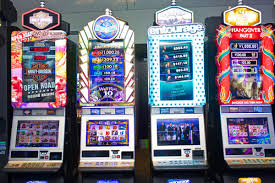Slot machines or one-armed bandits, as they’re more commonly known, have come a long way since Charles Fey first developed one-armed bandits in the late 19th century. At first they relied solely on physical reels with symbols like bells and sevens for betting purposes. But nowadays they feature much more sophisticated software programs with sophisticated mathematical calculations that enable their operation – from one-armed bandits with bells on them all the way to virtual ones with animation features!
Electromechanical machines were soon followed by video slots, providing more complex games with higher interactivity levels and more immersive interplay experiences.
Origins
Historically, slot machines were mechanical devices requiring players to insert coins and pull a lever, with results consisting of spinning reels filled with symbols like diamonds, spades, hearts, horseshoes, Liberty Bells etc. If any winning combinations lined up on one of these reels, prizes were distributed accordingly and this basic design earned slot machines their infamous name of one-armed bandits – one such machine was first created by Charles Fey of San Francisco during late 19th century.
These machines enabled players to win small amounts with each spin and provided them with an enjoyable gambling experience without complicated rules or gambling knowledge. Furthermore, these machines triggered an intense sensation of pleasure that caused their brains to associate them with high levels of Dopamine release; consequently many people continue playing these games even when they lose because they remain hopeful that another big win might trigger that dopamine rush and bring joyous feeling once more.
Developments
Early 1900s manufacturers started to introduce innovation. For instance, Industry Novelty Company developed Bell Fruit Gum as an anti-gambling device using symbols designed to bypass California’s anti-gambling laws and increase slot machine popularity within bars and saloons. This innovation marked an incredible advancement that increased slot machines popularity immensely.
Electromechanical slot machines were an enormous leap forward when introduced in the 1950s, featuring new payout schemes and accepting various coins types, along with a staggered stop function to automatically pay out specific symbols.
In the 1990s, slot machines underwent another significant evolution with online casinos becoming available to players from their homes. At the same time, video slot machines emerged that used digital screens to simulate reels on physical ones; this allowed developers to create more themes and bonus rounds than was possible with mechanical or electromechanical machines; plus it introduced random number generators, guaranteeing fair play for all.
Variations
Slot machines have evolved with technological advancements and player preferences over time, leading to various types of one-armed bandits as well as modern digital experiences offering immersive and captivating experiences for their users. Charles Fey introduced the first true slot machine with three mechanical reels in 1895. These early machines didn’t operate automatically; players would need to notify their owner whenever they won. These simple machines quickly gained popularity and soon became known as fruit machines due to their fruity symbols.
Bally made history again in 1964 with its introduction of an electromechanical slot that operated completely through electricity, garnering enormous praise and quickly replacing all levers with advanced electronics for greater complexity and new themes, bonus rounds and interactive gameplay – as well as jackpots that reached multi-million dollars! This innovation also gave rise to multi-million dollar jackpots!
Future
As technology advanced, slot machines began incorporating more intricate gameplay features. They became more interactive and immersive, engaging new audiences while keeping existing ones entertained. Microprocessors and random number generators (RNG) allowed manufacturers to design games featuring multiple paylines, symbols and themed bonus rounds; in turn leading to video slot machines featuring digital screens instead of physical reels with an assortment of themes.
Charles Fey may not have imagined how far slot machines have come since he created his Liberty Bell machine in 1895, but today they would likely be stunned at where they stand. Thanks to cutting-edge augmented and virtual reality technologies, players are transported into immersive worlds filled with engaging gameplay and visuals. Artificial Intelligence (AI) promises to further personalize player experiences by adapting themselves according to players’ individual preferences and habits.





